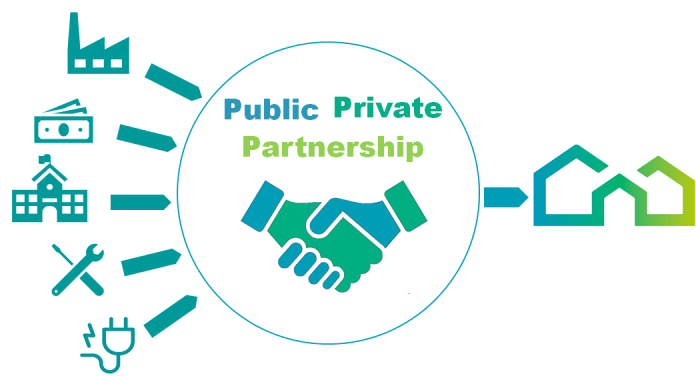This article has been written by Arti Sharma pursuing a Diploma in International Contract Negotiation, Drafting and Enforcement course from LawSikho and edited by Shashwat Kaushik.
This article has been published by Shashwat Kaushik.
Table of Contents
What are PPPs
A Public-Private partnership (PPP) is a contractual arrangement between a public-sector entity (such as a government agency) and a private-sector entity for the provision of public infrastructure or services. The goal of PPPs is to harness the strengths and powers of both the public and private sectors to efficiently deliver projects and services that might be challenging for either sector to undertake alone. In other words, it is the working together of two sectors and bringing up their resources collectively for their respective goals and objectives. According to the definition given by the World Bank of PPP, “it is a long term contract between a private party and a government agency for providing public assets. In particular, the private sector has to bear significant risk and have management responsibility as well.
In the context of infrastructure projects, PPP contracts typically involve a long-term collaboration between the public and private sectors.
Why PPPs is required for infrastructure projects
Here’s a breakdown of the key aspects:
Shared responsibilities
Both the public and private sectors contribute resources, expertise, and assets to the project. The public sector often provides the necessary regulatory framework, public funds, and oversight, while the private sector brings in funding, technical expertise, and operational efficiency. In short, the expertise of both entities is collaborated upon, and further responsibilities are shared on the basis of such a collaboration.
Risk sharing
There are many risks and unknown factors that can hinder its functioning. Major risks associated with the project, such as construction delays, cost overruns, or revenue generation, are shared between the public and private partners. This risk-sharing mechanism helps allocate risks to the party best equipped to manage them. The risk sharing also helps reduce stress and results in better management.
Financing
Private partners typically contribute financing to the project, reducing the burden on public budgets. This is often done through a combination of equity investments and loans. The ideal ratio of debt and equity is a combination of both debt and personal finance and equity.
There are a number of factors that can influence the optimal debt-equity ratio for a PPP project, including:
- The risk profile of the project
- The availability of debt financing
- The tax implications of debt and equity financing
- The preferences of the public sector partner
The risk profile of the project is a key factor in determining the optimal debt-equity ratio. A project with a high risk profile will require a higher level of equity financing to protect the public sector partner from potential losses. Conversely, a project with a low risk profile may be able to support a higher level of debt financing.
The availability of debt financing is another important factor. If debt financing is not readily available, the public sector partner may need to increase the equity contribution to the project.
The tax implications of debt and equity financing can also influence the optimal debt-equity ratio. In some cases, debt financing may be more tax-efficient than equity financing. This can be a factor in determining the optimal mix of debt and equity for a PPP project.

Long-term agreements
PPP contracts are often long-term agreements, spanning several years. This lets private partners recoup their investments and generate returns over the life of the project. This is also one of the reasons why private entities invest in such projects.
Performance-based payments
Payment to the private partner is often linked to the performance and delivery of specified services. Which results in good quality project management and execution by the private sector and therefore, high standards for the projects are maintained.
Transfer of assets
At the end of the contract term, ownership or operational control of the infrastructure may revert to the public sector. This transfer can be part of the agreement, ensuring that public assets are ultimately owned by the public. As the main intention behind such projects is always public development and welfare, the contribution of private entities amongst them is to boost such projects financially or by any means and maximise profit.
Innovation and efficiency
Private sector involvement can bring innovation and efficiency to project delivery and operation, as private entities are motivated by profit and competition. So, they come up with highly skilled human resources and technology to raise the project quality.
There are other key aspects of the PPP contracts, it’s cost-effective (as once the project is announced, bidding for the tender takes place and the lowest bid is chosen for the project), it brings private expertise into the contract, and it increases productivity.
Common types of infrastructure projects under PPP arrangements include transportation (roads, bridges, and airports), energy (power plants, utilities), water and sanitation, healthcare facilities, educational institutions, etc. While PPPs have the calibre to deliver benefits, they also pose challenges, including concerns about transparency, accountability, and the potential for private profit at the expense of public interest. Successful execution requires careful planning, clear contractual arrangements, and effective oversight to ensure that the public receives value for money and that the project meets its intended public service objectives.
Model of PPPs
There are various models of PPP that can be acquired for green field PPP and brown field PPP. Due to the multiplicity of the models, the PPP contracts are flexible to execute in the best way. Such models include:
- BOT model (Build Operate Transfer): This model involves a private company building a public infrastructure project, operating it for a certain period of time, and then transferring it back to the government.
- BOOT model (Build Own Operate Transfer): This model is similar to the BOT model, except that the private company owns the project after it is transferred back to the government.
- BOO model (Build Own Operate): This model involves a private company building and operating a public infrastructure project, but it does not transfer the project back to the government.
- BLT model (Build Lease Transfer): This model involves a private company building a public infrastructure project and then leasing it to the government for a certain period of time. After the lease expires, the project is transferred back to the government.
- TOT model (Toll Operate Transfer): This model involves a private company building and operating a toll road or bridge. After a certain period of time, the project is transferred back to the government, but the private company is allowed to collect tolls for a specified period of time.
- DBFO model (Design Build Finance Operate): This model involves a private company designing, building, financing, and operating a public infrastructure project. After a certain period of time, the project is transferred back to the government.
- OMDA model (Operation Management Development Agreement): This model involves a private company operating and managing a public infrastructure project. The private company does not own the project, but it is responsible for its day-to-day operations.
Examination of the PPP model
In order to understand the PPP model thoroughly, we first need to examine it on the basis of various factors and also look for the advantages and challenges faced by PPP in that very field. The public-private partnership (PPP) model has been subject to examination and evaluation from various perspectives to assess its effectiveness, advantages, and challenges. Here are some key areas that are often considered in the examination of the PPP model:
Efficiency and innovation
Advantage: PPPs can bring efficiency and innovation to public projects, as private sector involvement often introduces competition and a profit motive, driving improvements in project delivery and operations. And this competition helps increase the quality of the project.
Challenge: The effectiveness of efficiency gains depends on the design and management of the PPP, and in some cases, the private sector may prioritise profits over public service goals, which can lead to ill facets such as corruption, disregarding social welfare over money, etc.
Risk allocation
Advantage: PPPs allow for the allocation of risks to the party best equipped to manage them. This can lead to better risk management by sharing pressure, stress and mitigation strategies.
Challenge: If risks are not properly identified and allocated in the contract, it can lead to disputes, delays, and increased costs that will ultimately affect the degradation of public welfare.
Funding and financing
Advantage: PPPs can provide an alternative financing mechanism for public projects, reducing the burden on public budgets and leveraging private sector capital that can be invested in other useful sectors and projects as well.
Challenge: The financial viability of PPPs depends on the availability of suitable financing and the ability of the private sector to generate returns over the project’s life, which indirectly shows the incompetence and lack of funding with the public sector (the nation’s government).
Transparency and accountability
Advantage: PPP contracts often include performance statistics and transparency provisions, marketing accountability and ensuring that private partners meet specified service standards with no room for discretion or ambiguity.
Challenge: There can be concerns about transparency, especially in the negotiation and awarding of contracts, and the need for robust oversight mechanisms to prevent corruption and ensure the public interest.
Social and environmental impact
Advantage: PPPs can lead to the timely delivery of projects, benefiting communities by providing essential services and infrastructure. It helps in the overall development of society as a whole.
Challenge: There are concerns about the potential neglect of social and environmental considerations in the pursuit of profit, requiring careful regulation and monitoring. In other words, we can say it can also neglect the weaker sections of society.
Long-term commitments
Advantage: PPPs often involve long-term commitments, providing stability and continuity for the delivery of services over time.
Challenge: Long-term commitments can also pose challenges, especially if the private partner fails to meet obligations, leading to issues that persist over an extended period. Therefore, the assets are frozen( non-liquidated) and can’t be invested anywhere else for a longer period of time.

Flexibility and adaptability
Advantage: PPPs can be flexible in adapting to changing circumstances, allowing for adjustments in project scope or objectives during the contract period. It moves according to the needs and circumstances of the project and makes changes accordingly.
Challenge: Flexibility should be balanced with the need for contract stability to ensure that changes do not lead to disputes or negatively impact the project’s success.
In examining the PPP model, it’s crucial to consider the specific context, the regulatory framework, and the capacity of both the public and private sectors involved. Regular evaluation and lessons learned from previous PPPs contribute to the refinement of models and practices, ensuring that the benefits of public-private collaboration are maximised while mitigating potential drawbacks. One of the key factors to consider when evaluating the PPP model is the specific context in which it will be implemented. This includes factors such as the political environment, the economic situation, and social and cultural norms. The regulatory framework also plays an important role in determining the feasibility of a PPP. For example, a PPP may be more difficult to implement in a country with a complex and bureaucratic regulatory environment.
The capacity of both the public and private sectors is another important factor to consider. The public sector must have the capacity to manage a PPP effectively, and the private sector must have the capacity to deliver the services or infrastructure required. Regular evaluation and lessons learned from previous PPPs can help improve the capacity of both the public and private sectors to participate in PPPs.
By considering the specific context, the regulatory framework, and the capacity of both the public and private sectors, it is possible to refine the PPP model and maximise its benefits. Regular evaluation and lessons learned from previous PPPs can also help mitigate potential drawbacks. If we take an example of railway infrastructure that is based on the PPP model, it is very obvious that such a station will be equipped with facilities like cleanliness, safety measures, Wi-Fi, and surveillance performed via the Video Management System (VMS). And all these facilities mentioned above have actually been successfully completed at Rani Kamlapati Railway Station, Bhopal, and M.P.
On the other hand, if we take the same example of railway stations, then there is a very obvious problem of lack of interest in low-economic zones and last-mile connectivity because the main goal of private parties investing is profit maximisation, not providing facilities to remote areas. This causes an imbalance between the business goals of private entities and the social goals of the government.
Conclusion
In conclusion, public-private partnerships (PPPs) represent a complex and multifaceted approach to delivering public infrastructure and services. The examination of PPPs reveals both advantages and challenges, and the success of these partnerships depends on careful planning, transparent governance, and effective risk management.
In navigating the complexities of PPPs, policymakers and stakeholders must prioritise transparency, accountability, and the alignment of private and public interests. Regular evaluation, learning from experiences, and adapting models to specific contexts contribute to the continued refinement of PPP practices, ensuring that they effectively serve the public interest and contribute to sustainable development. As PPPs evolve, the focus should remain on maximising benefits for the public while addressing potential pitfalls through informed decision-making and adaptive governance.
For that, the Vijay Kalka Committee prepares a report on revisiting and revitalising the PPP model. The committee recommended checking affordability, prudent utilisation of the viability gap fund, and correct use of the Infrastructure PPP Adjudication Tribunal.
References
- https://www.pppinindia.gov.in/faqs#:~:text=Public%20Private%20Partnership%20(PPP)%20means,undertaken%20by%20the%20private%20sector
- https://blog.ipleaders.in/all-you-need-to-know-about-public-private-partnership-in-india/
- https://www.youtube.com/watch?v=NcJ6MJM7sxo&t=462s&ab_channel=Edukemy
 Serato DJ Crack 2025Serato DJ PRO Crack
Serato DJ Crack 2025Serato DJ PRO Crack










 Allow notifications
Allow notifications


